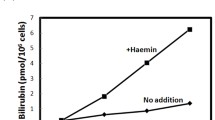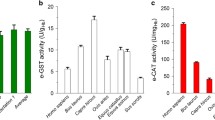Abstract
Hydroxylamine (HYAM, HONH2) and some of its derivatives are known to cause erythrotoxic effects both in vitro and in vivo. Previous studies have shown that the primary in vitro effect of HYAM and O-ethyl hydroxylamine (OEH) is methaemoglobin formation, leading to liberation of free radicals which cause lipid peroxidation, enzyme inhibitions and glutathione depletion. By contrast, N-substituted N,O-dimethyl hydroxylamine (NODMH), primarily induces impairment of glucose 6-phosphate dehydrogenase (G6PDH) and glutathione reductase (GR). The oxidative potency of HYAM and the O-derivative was larger than the potency of the N,O-derivative. This seemed to indicate that attachment of an alkyl group to the nitrogen atom of hydroxylamine leads to decreased reactivity. To achieve a better understanding of the structure activity relationship for hydroxylamines three methylated derivatives were tested: N-methyl hydroxylamine (NMH), N-dimethyl hydroxylamine (NDMH) and O-methyl hydroxylamine (OMH). We were also interested in the erythrotoxic potency of OMH which recently entered industrial production. Methaemoglobin formation, high release of lipid peroxidation products, inhibition of NADPH methaemoglobin reductase and glutathione S-transferase (GST) and depletion of total glutathione (GT) were seen for OMH. The reducing enzymes G6PDH and GR were not impaired by OMH. These findings for OMH are consistent with the proposed mechanism for O-derivatives. Since both the effects caused by OMH and its potency are comparable to those of HYAM and OEH this indicates that possible occupational exposure to this compound may be approached similarly to HYAM and OEH. NMH only inhibited G6PDH and GR activity, which is fully in accord with the proposed mechanism for N-substituted derivatives of HYAM. However, NDMH a double N-substituted compound, caused a strikingly different scheme of reactivity: inhibition of G6PDH but not of GR, severe methaemoglobin formation, only little lipid peroxidation and some impairment of NADPH methaemoglobin reductase. This study confirms that O-derivatives of HYAM are potent haemoglobin oxidators, leading to other oxidative effects. The main effect was confirmed for single N-derivatives as inhibition of the two protective enzymes G6PDH and GR. However, the results for NDMH indicate that this simple classification of O-derivatives and N-derivatives has to be extended for double N-substituted compounds which give a mixture of effects.
Similar content being viewed by others
Author information
Authors and Affiliations
Additional information
Received: 26 September 1996 / Accepted: 8 November 1996
Rights and permissions
About this article
Cite this article
Spooren, A., Evelo, C. In vitro haematotoxic effects of three methylated hydroxylamines. Arch Toxicol 71, 299–305 (1997). https://doi.org/10.1007/s002040050390
Issue Date:
DOI: https://doi.org/10.1007/s002040050390




